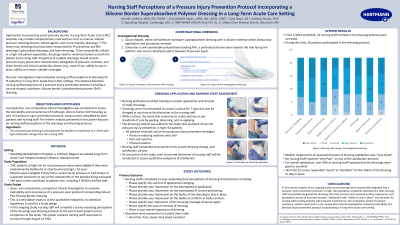Clinical Research
(CR-031) Nursing Staff Perceptions of a Pressure Injury Prevention Protocol Incorporating a Silicone Border Super-absorbent Polymer Dressing in Long-term Acute Care Setting
Friday, May 2, 2025
7:45 PM - 8:45 PM East Coast USA Time

Chrystalbelle Rogers, MSN, RN, CWCN, CENP – Director of Clinical Services, Hartmann USA; Syed Naqvi, B.S. – Department of Population and Quantitative Health Sciences – University of Massachusetts Medical School; Anthony Nunes, PhD – Assistant Professor, Department of Population and Quantitative Health Sciences, University of Massachusetts Medical School
Introduction: Approaches to preventing sacral pressure injuries in Long-Term Acute Care (LTAC) hospitals may include complementary interventions such as manual rotation, pressure reducing devices, topical agents, and, more recently, dressings. This abstract describes nursing staff perspectives of a pressure injury prevention protocol including a sacrum-shaped, multi-layer, silicone super-absorbent polymer dressing.
Methods: A prospective, non-comparative clinical investigation was conducted to assess the tolerability and convenience of super absorbent polymer dressings for pressure injury prevention, using surveys completed by both patients and nursing staff. This abstract focuses on the results from the surveys of nursing staff who applied the dressings to patients at high risk of developing pressure ulcer, according to the Braden scale. Dressing replacement was performed at the discretion of the clinical staff but no less than once every 7 days. Nursing staff completed surveys evaluating their perceptions of dressing characteristics including comfort, application and removal ease, coverage of the dressing, ability of the dressing to stay in place, and their overall impression of the dressing. All questions were assessed on a 5-point Likert scale ranging from 1 (very poor) to 5 (excellent).
Results: From 1/2024 to 8/2024, 22 nursing staff involved in the dressing protocol were surveyed. During this time, 28 patients participated in the dressing protocol. Nursing staff unanimously reported that the ease of the dressing application and removal was good-excellent. The ability of the dressing to stay in place was rated highly, with a median response of 4 (very good) and 75% of nursing staff reporting values between 3 and 5 (good-excellent). For overall satisfaction, over 95% of nursing staff reported that the dressings were good to excellent.
Discussion: In this interim analysis of our ongoing study, sacral dressings were successfully integrated into a pressure injury prevention protocol in a high-risk population of patients admitted to a LTAC. Nursing staff successfully integrated the dressings into their protocol and reported positive experiences and perceptions.
Methods: A prospective, non-comparative clinical investigation was conducted to assess the tolerability and convenience of super absorbent polymer dressings for pressure injury prevention, using surveys completed by both patients and nursing staff. This abstract focuses on the results from the surveys of nursing staff who applied the dressings to patients at high risk of developing pressure ulcer, according to the Braden scale. Dressing replacement was performed at the discretion of the clinical staff but no less than once every 7 days. Nursing staff completed surveys evaluating their perceptions of dressing characteristics including comfort, application and removal ease, coverage of the dressing, ability of the dressing to stay in place, and their overall impression of the dressing. All questions were assessed on a 5-point Likert scale ranging from 1 (very poor) to 5 (excellent).
Results: From 1/2024 to 8/2024, 22 nursing staff involved in the dressing protocol were surveyed. During this time, 28 patients participated in the dressing protocol. Nursing staff unanimously reported that the ease of the dressing application and removal was good-excellent. The ability of the dressing to stay in place was rated highly, with a median response of 4 (very good) and 75% of nursing staff reporting values between 3 and 5 (good-excellent). For overall satisfaction, over 95% of nursing staff reported that the dressings were good to excellent.
Discussion: In this interim analysis of our ongoing study, sacral dressings were successfully integrated into a pressure injury prevention protocol in a high-risk population of patients admitted to a LTAC. Nursing staff successfully integrated the dressings into their protocol and reported positive experiences and perceptions.

.jpg)